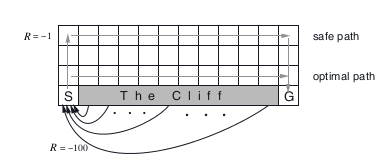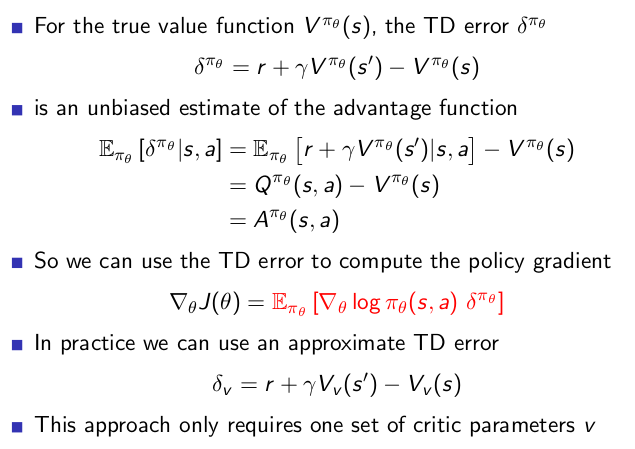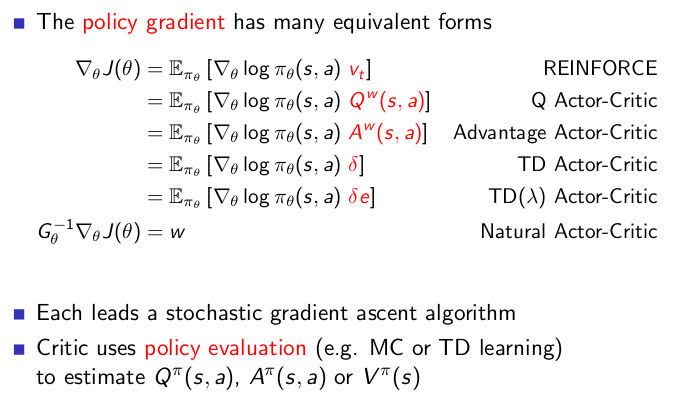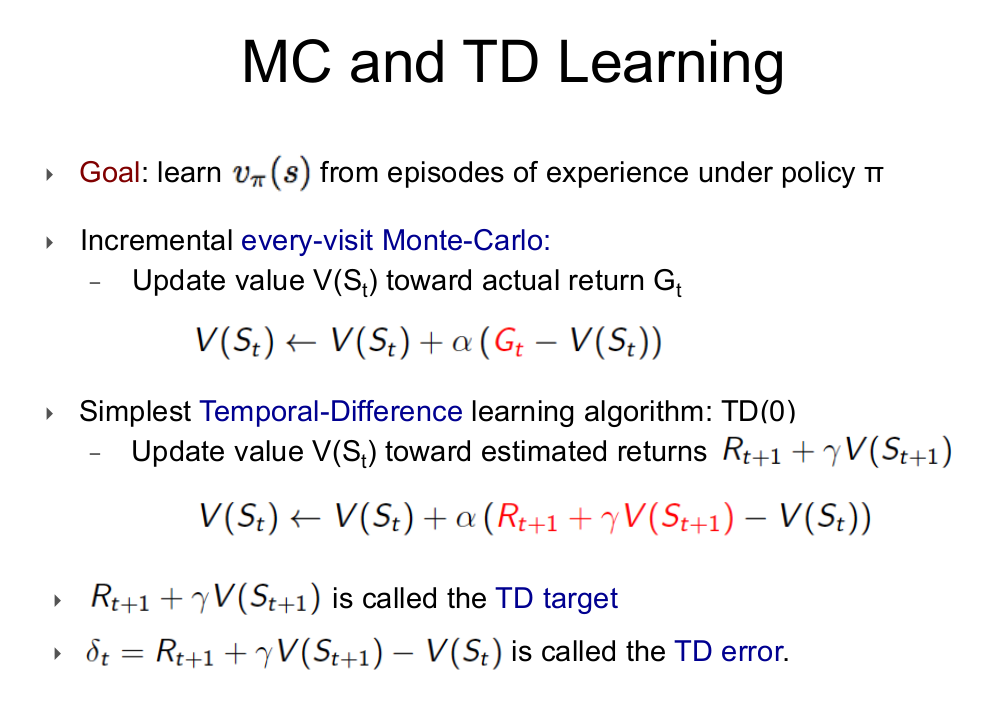Advantage Actor-Critic Example
Understand Actor-Critic (AC) algorithms
- Learned Value Function
- Learned Policy
- this example uses Advantage Actor(policy weight)-Critic(Value Weight) Algorithm
Monte Carlo Policy Gradient sill has high variance so critic estimates the action-value function
- critic updates action-value function parameters w
- actor updates policy parameter
tensorflow main code
- initialize tensorflow graph
- create session
- run actor_critic function
# reset tensor flow graph
tf.reset_default_graph()
# non-trainable, global step tensorflow variable
global_step = tf.Variable(0, name="global_step", trainable=False)
# create Policy Estimator => actor
policy_estimator = PolicyEstimator()
# create Value Estimator => critic
value_estimator = ValueEstimator()
with tf.Session() as sess:
# initialize tensorflow session variables
sess.run(tf.initialize_all_variables())
# Note, due to randomness in the policy the number of episodes
# you need to learn a good policy may vary. ~300 seemed to work well for me.
stats = actor_critic(env, policy_estimator, value_estimator, 300)
def actor_critic(env, estimator_policy, estimator_value, num_episodes, discount_factor=1.0):
"""
Actor Critic Algorithm. Optimizes the policy
function approximator using policy gradient.
Args:
env: OpenAI environment. => class CliffWalkingEnv
estimator_policy: Policy Function to be optimized ,class PolicyEstimator
estimator_value: Value function approximator, used as a critic, class ValueEstimator
num_episodes: Number of episodes to run for
discount_factor: Time-discount factor
Returns:
An EpisodeStats object with two numpy arrays for episode_lengths
and episode_rewards.
"""
# Keeps track of useful statistics
stats = plotting.EpisodeStats(
episode_lengths=np.zeros(num_episodes),
episode_rewards=np.zeros(num_episodes))
'''
>>> # collections.namedtuple Basic example
>>> Point = namedtuple('Point', ['x', 'y'])
>>> p = Point(11, y=22) # instantiate with positional or keyword arguments
>>> p[0] + p[1] # indexable like the plain tuple (11, 22)
33
>>> x, y = p # unpack like a regular tuple
>>> x, y
(11, 22)
>>> p.x + p.y # fields also accessible by name
33
>>> p # readable __repr__ with a name=value style
Point(x=11, y=22)
'''
Transition = collections.namedtuple("Transition", ["state", "action", "reward",
"next_state", "done"])
'''
t = Transition(state=state, action=action, reward=reward, next_state=next_state,
done=done)
t.state, t.action
'''
# for example, num_episodes = 300
for i_episode in range(num_episodes):
# Reset the environment and pick the fisrst action
state = env.reset() # class CliffWalkingEnv
episode = []
# One step in the environment
# itertools example http://jmduke.com/posts/a-gentle-introduction-to-itertools/
# itertools.count() from 0 to unlimited count, if done is true, this loop stops
for t in itertools.count():
# Take a step
action_probs = estimator_policy.predict(state)
action = np.random.choice(np.arange(len(action_probs)), p=action_probs)
next_state, reward, done, _ = env.step(action)
# Keep track of the transition
episode.append(Transition(
state=state, action=action, reward=reward, next_state=next_state, done=done))
# Update statistics
stats.episode_rewards[i_episode] += reward
stats.episode_lengths[i_episode] = t
# Calculate TD Target
value_next = estimator_value.predict(next_state)
td_target = reward + discount_factor * value_next
td_error = td_target - estimator_value.predict(state)
# Update the value estimator
estimator_value.update(state, td_target)
# Update the policy estimator
# using the td error as our advantage estimate
estimator_policy.update(state, td_error, action)
# Print out which step we're on, useful for debugging.
print("\rStep {} @ Episode {}/{} ({})".format(
t, i_episode + 1, num_episodes, stats.episode_rewards[i_episode - 1]), end="")
if done:
break
state = next_state
return stats
itertools tf.one_hot tf.placeholder tf.squeeze
class PolicyEstimator():
"""
Policy Function approximator.
"""
def __init__():
# state 4 X 12
# action UP=0 RIGHT=1 DOWN=2 LEFT=3
# target is td_error => td_target - estimator_value.predict(state)
self.state = tf.placeholder(tf.int32, [], "state")
self.action = tf.placeholder(dtype=tf.int32, name="action")
self.target = tf.placeholder(dtype=tf.float32, name="target")
# This is just table lookup estimator
# openai gym class CliffWalkingEnv(discrete.DiscreteEnv)
# refer to the below code self.observation_space = spaces.Discrete(self.nS)
# env.observation_space.n => 4 X 12 = 48
state_one_hot = tf.one_hot(self.state, int(env.observation_space.n))
# state_one_hot => (48,)
# env.action_space.n => 4 UP=0 RIGHT=1 DOWN=2 LEFT=3
self.output_layer = tf.contrib.layers.fully_connected(
inputs=tf.expand_dims(state_one_hot, 0),
num_outputs=env.action_space.n,
activation_fn=None,
weights_initializer=tf.zeros_initializer)
# selected action from softmax layer
# softmax(self.output_layer) is softmax policy for discrete actions
# refer to below softmax policy figure
# output_layer => (1,4)
# softmax => (1,4)
# squeeze => (4,)
# action_probs = (4,)
# picked_action_prob : gather ()-> float32
self.action_probs = tf.squeeze(tf.nn.softmax(self.output_layer))
self.picked_action_prob = tf.gather(self.action_probs, self.action)
# Loss and train op
self.loss = -tf.log(self.picked_action_prob) * self.target
self.optimizer = tf.train.AdamOptimizer(learning_rate=learning_rate)
self.train_op = self.optimizer.minimize(
self.loss, global_step=tf.contrib.framework.get_global_step())
def predict(self, state, sess=None):
# sess or use default tensorflow session
sess = sess or tf.get_default_session()
# run self.action_prob with {state}
return sess.run(self.action_probs, { self.state: state })
def update(self, state, target, action, sess=None):
sess = sess or tf.get_default_session()
feed_dict = { self.state: state, self.target: target, self.action: action }
_, loss = sess.run([self.train_op, self.loss], feed_dict)
return loss
class ValueEstimator():
"""
Value Function approximator.
"""
def __init__(self, learning_rate=0.1, scope="value_estimator"):
with tf.variable_scope(scope):
self.state = tf.placeholder(tf.int32, [], "state")
self.target = tf.placeholder(dtype=tf.float32, name="target")
# This is just table lookup estimator
state_one_hot = tf.one_hot(self.state, int(env.observation_space.n))
self.output_layer = tf.contrib.layers.fully_connected(
inputs=tf.expand_dims(state_one_hot, 0),
num_outputs=1,
activation_fn=None,
weights_initializer=tf.zeros_initializer)
self.value_estimate = tf.squeeze(self.output_layer)
self.loss = tf.squared_difference(self.value_estimate, self.target)
self.optimizer = tf.train.AdamOptimizer(learning_rate=learning_rate)
self.train_op = self.optimizer.minimize(
self.loss, global_step=tf.contrib.framework.get_global_step())
def predict(self, state, sess=None):
sess = sess or tf.get_default_session()
return sess.run(self.value_estimate, { self.state: state })
def update(self, state, target, sess=None):
sess = sess or tf.get_default_session()
feed_dict = { self.state: state, self.target: target }
_, loss = sess.run([self.train_op, self.loss], feed_dict)
return loss
below code snippet is actor-critic algorithm flow
- loop in each episode
- current state, take current action, run environment
- take next state, next reward, game done signal from environment
- calculate estimated value of next state
- calculate td_target = reward + discount_factor* next estimated value
- calculate td_error = td_target - current estimated value
- update state value with current state and td_target
- update policy weight with current state, td_error and current action
- loop goes until game is done
- state update with next state

# Take a step
action_probs = estimator_policy.predict(state)
action = np.random.choice(np.arange(len(action_probs)), p=action_probs)
next_state, reward, done, _ = env.step(action)
action_probs is estimated action lists of current state. action_prob is an output from softmax probabilities regarding 4 actions(self.action_probs = tf.squeeze(tf.nn.softmax(self.output_layer)). And action is the selected value in action lists
env.step(action) generates next_state,next reward, done signal
# Calculate TD Target
value_next = estimator_value.predict(next_state)
td_target = reward + discount_factor * value_next
# td_target - current state's value => td_error
td_error = td_target - estimator_value.predict(state)
# Update the value estimator
estimator_value.update(state, td_target)
# ValueEstimator()
# self.value_estimate = tf.squeeze(self.output_layer)
# self.loss = tf.squared_difference(self.value_estimate, self.target)
# Update the policy estimator
# using the td error as our advantage estimate
estimator_policy.update(state, td_error, action)
# PolicyEstimator()
# softmax output : picked_action_prob, target: td_error
# self.loss = -tf.log(self.picked_action_prob) * self.target
Summarize Actor-Critic Algo
Critic minimized the this loss function: (estimated value of current state from DNN - td_target)
Actor estimates the td_error plus current estimated action from policy network
Explain Critic Algo
estimator_value.update(state,td_target) runs critic algorithm, self.loss tensor in update function related with tf.squared_difference(self.value_estimate, self.target),self.value_estimate is the current value from current state and this is
in the TD(0) Critic Algo. Critic can esitmate value function
from various target.
Basic TD(0) Critic Algo is below formula
can be a deep neural network with parameter W, so self.train_op tries to minimize loss function with self.optimizer.minimize. And here we used self.output_layer where we used one tf.contrib.layers.fully_connected layer. This fully connected layer has one state input and one output(current estimated state value with parameter W)
td_target is
and self.target means this td_target.
so critic is updated to minimize MSE with regard to target given by MC or TD(0)
=>tf.squared_difference(self.value_estimate, self.target)
Explain Actor Algo
the policy gradient can also be estimated as follows:
Actor-Critic policy gradient uses the one-step TD error
, from the code -tf.log(self.picked_action_prob) * self.target where self.target is td_error and self.picked_action_prob is softmax output.
Q: how to explain about
in score function
(softmax policy : discrete actions)
Estimating the Advantage Actor-Critic
1
2
self.action_probs = tf.squeeze(tf.nn.softmax(self.output_layer))
self.picked_action_prob = tf.gather(self.action_probs, self.action)
 —
—
Example cliff-walk with Actor-Critic algo
The cliff-walking task. The results are from a single run, but smoothed by averaging the reward sums from 10 successive episodes.

from lib.envs.cliff_walking import CliffWalkingEnv
#this example test cliff walking
from lib import plotting
#create openai gym
env = CliffWalkingEnv()
# CliffWalking Environment
class CliffWalkingEnv(discrete.DiscreteEnv):
metadata = {'render.modes': ['human', 'ansi']}
def __init__(self):
# maze size is 4 X 12 matrix
self.shape = (4, 12)
# np.prod => Return the product of array elements over a given axis.
nS = np.prod(self.shape) # nS => 4*12
nA = 4
# Cliff Location
self._cliff = np.zeros(self.shape, dtype=np.bool)
self._cliff[3, 1:-1] = True # cliff postion
# Calculate transition probabilities
P = {}
# nS = 4*12 = 48
for s in range(nS):
# Converts a flat index or array of flat indices
# into a tuple of coordinate arrays.
# s = 47 , temp_shape = (4 ,12)
# position = np.unravel_index(s, temp_shape)
# position = (3 ,11)
position = np.unravel_index(s, self.shape)
P[s] = { a : [] for a in range(nA) }
P[s][UP] = self._calculate_transition_prob(position, [-1, 0])
P[s][RIGHT] = self._calculate_transition_prob(position, [0, 1])
P[s][DOWN] = self._calculate_transition_prob(position, [1, 0])
P[s][LEFT] = self._calculate_transition_prob(position, [0, -1])
# We always start in state (3, 0)
isd = np.zeros(nS)
isd[np.ravel_multi_index((3,0), self.shape)] = 1.0
super(CliffWalkingEnv, self).__init__(nS, nA, P, isd)
env._cliff
>>>
array([[False, False, False, False, False, False, False, False, False,
False, False, False],
[False, False, False, False, False, False, False, False, False,
False, False, False],
[False, False, False, False, False, False, False, False, False,
False, False, False],
[False, True, True, True, True, True, True, True, True,
True, True, False]])
env.P[0] # 0:UP,1:RIGHT,2:DOWN,3:LEFT :{(1.0,new_state(0~47),reward(-1 or -100),is_done)}
>>>
{0: [(1.0, 0, -1.0, False)],
1: [(1.0, 1, -1.0, False)],
2: [(1.0, 12, -1.0, False)],
3: [(1.0, 0, -1.0, False)]}
def _calculate_transition_prob(self, current, delta):
new_position = np.array(current) + np.array(delta)
new_position = self._limit_coordinates(new_position).astype(int)
new_state = np.ravel_multi_index(tuple(new_position), self.shape)
reward = -100.0 if self._cliff[tuple(new_position)] else -1.0
is_done = self._cliff[tuple(new_position)] or (tuple(new_position) == (3,11))
return [(1.0, new_state, reward, is_done)]
# current =(0,0), delta =[-1,0]
new_position = np.array(current) + np.array(delta)
>> new_position [-1,0]
# check shape limit size (4,12)
new_position = self._limit_coordinates(new_position).astype(int)
>> new_position [0,0]
print((tuple(new_position)))
>>(0,0)
# self.shape = (4,12), tuple(new_position) = (0,0)
new_state = np.ravel_multi_index(tuple(new_position), self.shape)
>> 0 # new_state is index of (4*12) array (0,0)->0 , (1,0) -> 12
reward = -100.0 if self._cliff[tuple(new_position)] else -1.0 # reward -1 or -100(cliff)
# is_done is true if position is cliff or arrives goal(3,11)
is_done = self._cliff[tuple(new_position)] or (tuple(new_position) == (3,11))
openAI gym DiscreteEnv super(CliffWalkingEnv, self).init(nS, nA, P, isd) initializes below open ai environment
class DiscreteEnv(Env):
"""
Has the following members
- nS: number of states
- nA: number of actions
- P: transitions (*)
- isd: initial state distribution (**)
(*) dictionary dict of dicts of lists, where
P[s][a] == [(probability, nextstate, reward, done), ...]
(**) list or array of length nS
"""
def __init__(self, nS, nA, P, isd):
self.P = P
self.isd = isd
self.lastaction=None # for rendering
self.nS = nS
self.nA = nA
self.action_space = spaces.Discrete(self.nA)
self.observation_space = spaces.Discrete(self.nS)
#episode plotting
#episode size 300
print(len(stats.episode_lengths))
>> 300
cumsum = np.cumsum(stats.episode_lengths)
print(stats.episode_lengths[:10])
print(cumsum[:10])
>>[ 3. 1. 8. 0. 1. 31. 4. 6. 2. 33.]
>>[ 3. 4. 12. 12. 13. 44. 48. 54. 56. 89.]




